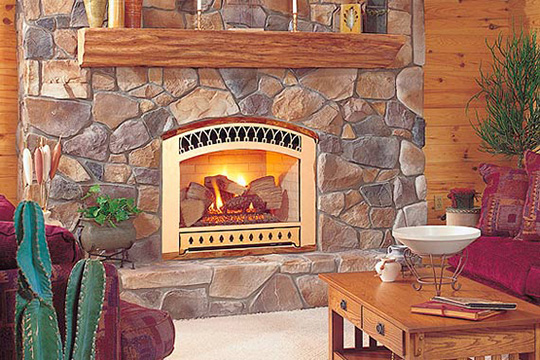Flip a switch; have fire. That’s the key appeal of a gas fireplace insert. You still enjoy real flames, but without the hassles of solid fuel. There is no firewood to stack, bags of pellets to dump, and no ashes to clean out. The air inside your house and in your neighborhood stays clean, too. No wonder that about 70% of all hearth products—fireplaces, inserts, and artificial log sets—now burn gas.
Unlike old decorative gas fireplaces, today’s gas inserts are heat-producing dynamos that use natural gas or propane to power a steady flame dancing on fake logs, decorative modern glass chips, or stones behind a sealed glass face.
Gas inserts are available as vented units or unvented units.
- Direct-vent units are safest. They draw in outside air to keep the flame burning and exhaust all the combustion gases and water vapor released by burning gas.
- Ventless inserts have a higher efficiency rating (92% to 99% vs. 60% to 80% for direct-vent inserts) because no heat escapes up the chimney. But the exhaust fumes and moisture released from burning gas stay in your house, which may be a cause for concern.
Most ventless gas fireplace inserts are considered safe for homeowners because they include an oxygen-depletion sensor that turns gas off before carbon monoxide reaches dangerous levels in the room. Nevertheless, some states don’t allow ventless gas units.
Check your local building codes regarding the types of fireplace inserts allowed in your area.
Capacity and Cost of Inserts
A gas-burning fireplace insert heats 1,000 to 3,000 square feet, depending on its size. Talk to your insert dealer about the size of your existing fireplace and what heating capacity you can expect from an insert.
Inserts cost $3,000 to $4,000, including installation and a chimney liner.
Upsides to a Gas Fireplace Insert
- Gas fireplace inserts can be used in masonry or prefab fireplaces; they can be vented through the existing chimney (or a wall for a free-standing unit).
- Gas inserts require little maintenance beyond an annual $75 to $125 checkup. Its best application is for zone heating—turning up the gas in the room you’re in and lowering the thermostat in the rest of your house.
- There’s a definite green factor — they burn with a 65% to 99% efficiency rating, which means very little pollution or smoke.
- There’s no ash or creosote produced with a gas-burning unit.
On the Downside
- Propane is an expensive heating fuel — you won’t save money heating your whole house with a gas insert.
- You’ll spend more on gas or propane than you would on wood or pellets to produce the same amount of heat.
- You won’t enjoy the snap, pop, and aroma of a real fire.
Related:
